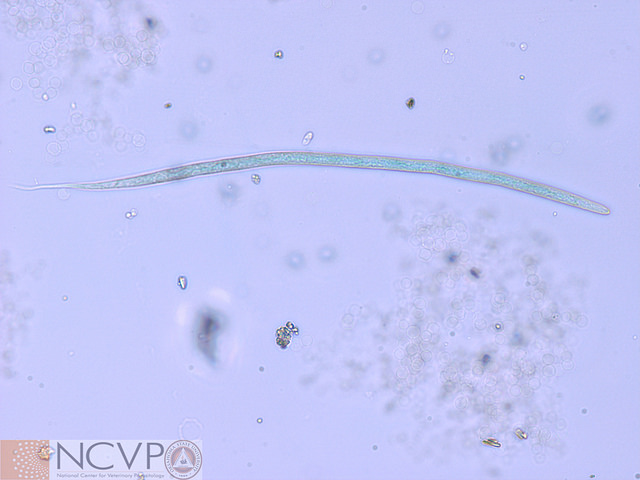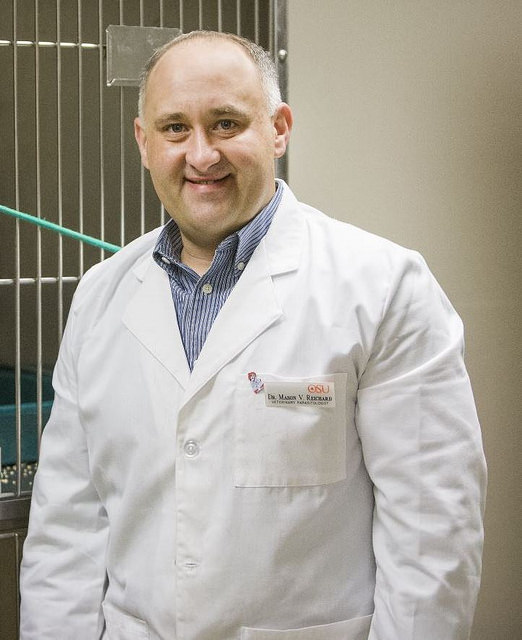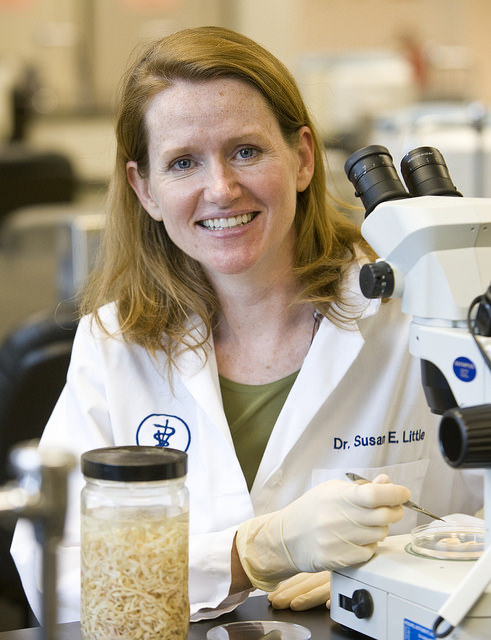Parasites beware; National Center for Veterinary Parasitology at Oklahoma State University has its eyes on you
Friday, July 25, 2014
 |
 |
 |
The world’s battle against parasites has a young, aggressive ally.
Launched in 2009, the National Center for Veterinary Parasitology (NCVP) at Oklahoma
State University’s Center for Veterinary Health Sciences is helping carry the fight
against parasites and vectors, such as mosquitoes, ticks, and the organisms they transmit.
These foes attack humans, animals and our food supply.
The National Center for Veterinary Parasitology is the only one of its kind and began
with the financial backing of the Kirkpatrick Foundation, Novartis Animal Health,
Bayer Animal Health and Merial.
“The concept was novel. Create a clearinghouse for all things related to veterinary
parasitology, support clinical parasitology research, and develop the next generation
of veterinary parasitologists,” said Susan Little, DVM, PhD, DACVM (Parasit.), OSU
Regents Professor, Krull-Ewing Chair in Veterinary Parasitology and co-director of
the NCVP.
This year, Merck, Zoetis, and Elanco joined the other continuing sponsors to provide
sustaining support and establish industry resident positions. The NCVP residents are
nationally recognized stars in their field.
“Before the NCVP, there was no pipeline for future talent specific to veterinary parasitology,”
Little said. “The need for veterinary parasitologists has grown but with a limited
supply. Both academia and the pharmaceutical industry need well-trained clinical researchers
to effectively combat parasitic and vector-borne diseases.”
Heartworm is one National Center for Veterinary Parasitology success story.
Little said heartworm diagnosis has been based on antigen testing to detect proteins
of the parasite in the blood of dogs and cats, and antigen tests are very sensitive
and specific.
“Because of research at the NCVP, we now know that many infected dogs, and perhaps
most infected cats, may not test positive even though they have worms,” Little said.
“Fortunately, this research also identified a simple, in-clinic modification to the
test to address the problem. This is just one example of how NCVP parasitologists
can help veterinarians practice better medicine.”
The NCVP at Oklahoma State University is sharing its knowledge through its website
(http://www.ncvetp.org), where teachers from all over the world can access a database
with hundreds of parasite images at no cost. In addition, other teaching resources
include a ‘case of the month’ and a Jeopardy-style parasitology review game.
“Giving educators access to accurate and compelling parasitology information and research
helps strengthen knowledge about parasitology and increases the interest in the discipline
world-wide,” said Little.
The diagnostic arm of the NCVP is expanding its impact according to Eileen Johnson,
DVM, MS, PhD, who is an associate clinical professor at Oklahoma State University
and the diagnostic veterinary parasitologist for the center.
“The diagnostic lab processes hundreds of samples each month for veterinarians in
practice and for other reference labs,” said Johnson. “Most of the samples are from
small animals, many from shelter animals. Some of the most common findings include
hookworms, which can cause severe anemia in young animals, as well as coccidia, Giardia,
roundworms, and whipworms, which can cause diarrhea.”
Johnson said many of these parasites are zoonotic and can cause disease in people,
so identifying and treating the infections are particularly important. The center
also provides egg per gram counts for horses and cattle, allowing veterinarians to
tailor integrated parasite management programs and monitor treatment effectiveness.
In addition to processing diagnostic samples, the clinical parasitology lab collects
materials to be used for teaching courses at Oklahoma State University and at other
veterinary colleges. Johnson teaches residents and graduate students a special problems
course in diagnostic parasitology best practices.
“The NCVP provides information to veterinarians to help them recognize parasites in
the animals they treat,” said Little. “An accurate, early diagnosis can cut down on
the cost of treatment for the owner and hopefully bring the pet back to a healthy
state faster.”
The latest addition to the NCVP is a small grants program that provides funding for
one-year projects to address specific problems in clinical or basic veterinary parasitology.
“Student involvement in the project is required, which gives us one more opportunity
to get younger scientists excited about parasitology research,” Little said. “All
of this is made possible through our sponsoring partners and we are forever grateful
for their continued support.”
Plans for the coming year at the National Center for Veterinary Parasitology include
additional ways to provide helpful information to parasitologists, veterinarians and
the public. Look for videos on best practices in parasite control, new images of veterinary
parasites, interesting cases involving veterinary parasitology, and more.
